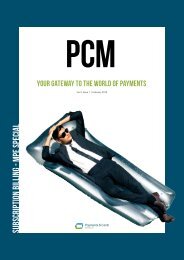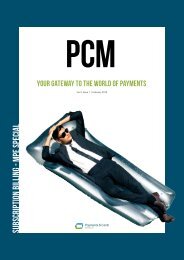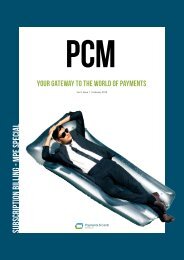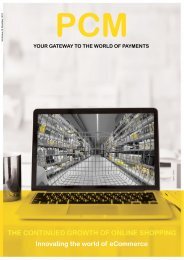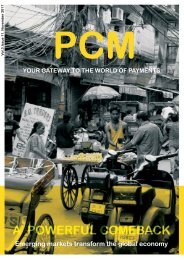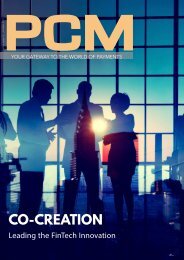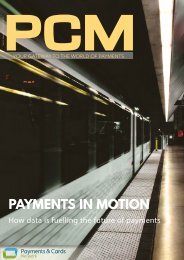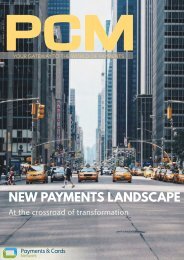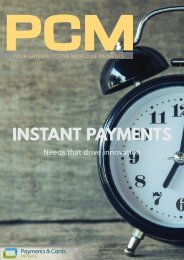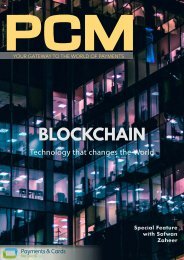PCM Vol.2 - Issue 6
Create successful ePaper yourself
Turn your PDF publications into a flip-book with our unique Google optimized e-Paper software.
expert interview<br />
Understanding the<br />
Total Cost of Friction<br />
Armen leads worldwide marketing strategy and<br />
execution for ThreatMetrix. Previously, he directed<br />
the go-to-market strategy for IBM’s $1B portfolio of<br />
100+ SaaS solutions. Armen joined IBM through<br />
the $440M acquisition of DemandTec, where as VP<br />
of Corporate Marketing he built a modern demand<br />
generation engine and repositioned the business<br />
supporting a 3x increase in revenue over a 5 year<br />
span.<br />
Armen Najarian<br />
CMO, ThreatMetrix<br />
Tech-savvy millenials are<br />
becoming the predominant<br />
demographic as customers as<br />
well as employees. We talk to<br />
Armen Najarian from ThreatMetrix,<br />
about the right balance of remaining the<br />
competitive with new tech innovation<br />
whilst not compromising the customer<br />
experience.<br />
PCN: When you talk about ‘Digital<br />
Transformation’ in the Financial<br />
Services industry, what does that mean<br />
to you?<br />
AN: Digital Transformation as it relates<br />
to fraud and security breaches is no<br />
longer just an IT issue, it’s a business<br />
issue. Banks don’t typically measure<br />
the cost of friction but the tangible<br />
losses are in the billions. Banking and<br />
Commerce transactions are increasingly<br />
done online or via mobile devices and<br />
we’re putting our personal information<br />
out there at an accelerated rate. This<br />
creates greater opportunity for fraud<br />
and security breaches.<br />
When fraud occurs two things happen: 1.<br />
the industry responds by implementing<br />
stricter authentication measures -<br />
passwords, captchas, verification<br />
codes - that end up hampering the<br />
user experience, and 2. customers lose<br />
trust. Adding more hoops for users to<br />
jump through degrades their experience<br />
enough that they can be willing to walk<br />
away - creating financial loss. On the same<br />
hand, loss of customer trust means that<br />
they won’t be recommending services to<br />
friends and family, and that also results<br />
in financial loss. Digital transformation<br />
effectively addresses business concerns<br />
and IT concerns, minimizing customer<br />
friction while tackling fraud.<br />
PCN: In March, 2016, First Annapolis<br />
conducted a study* on behalf of<br />
ThreatMetrix on controlling friction<br />
while tackling cybercrime. What<br />
surprised you most about the data?<br />
AN: There were a couple of things. The<br />
sheer volume of individuals using digital<br />
means for important transactions, and<br />
the high cost of loss due to fraud and<br />
friction. In our study, 38% of people<br />
reported experience with banking and<br />
payments fraud within a 3-year period.<br />
66% had their payment card information<br />
compromised, while 45% said their<br />
information was used to make online<br />
or mobile purchases. Because of fraud,<br />
90% took actions to secure their account<br />
and 34% changed their behavior, but<br />
10% actually left their bank. Of the<br />
demographics, millennials were more<br />
inclined to take action as a result of real<br />
or perceived problems.<br />
Let’s talk about that 10%. Assume that<br />
of 215.1MM banked consumers, 9%<br />
experienced fraud in the last 12 months.<br />
That’s 19.4MM fraud victims, of which,<br />
the 10% that left/will leave amounts to<br />
around 1.9MM relationships lost. No<br />
matter what the dollar value of those<br />
relationships, that’s a staggering loss.<br />
PCN: As a consumer, wouldn’t you<br />
rather go through challenges than risk<br />
compromising your identity and data?<br />
AN: The Catch-22 for the industry is that<br />
the cost of fraud and fraud prevention<br />
is significant, but so is the cost of<br />
friction created by customer-facing<br />
step-up challenges. The study shows<br />
that fraud and the customer response<br />
to it don’t vary much by geography<br />
or demographics. The majority of<br />
013





